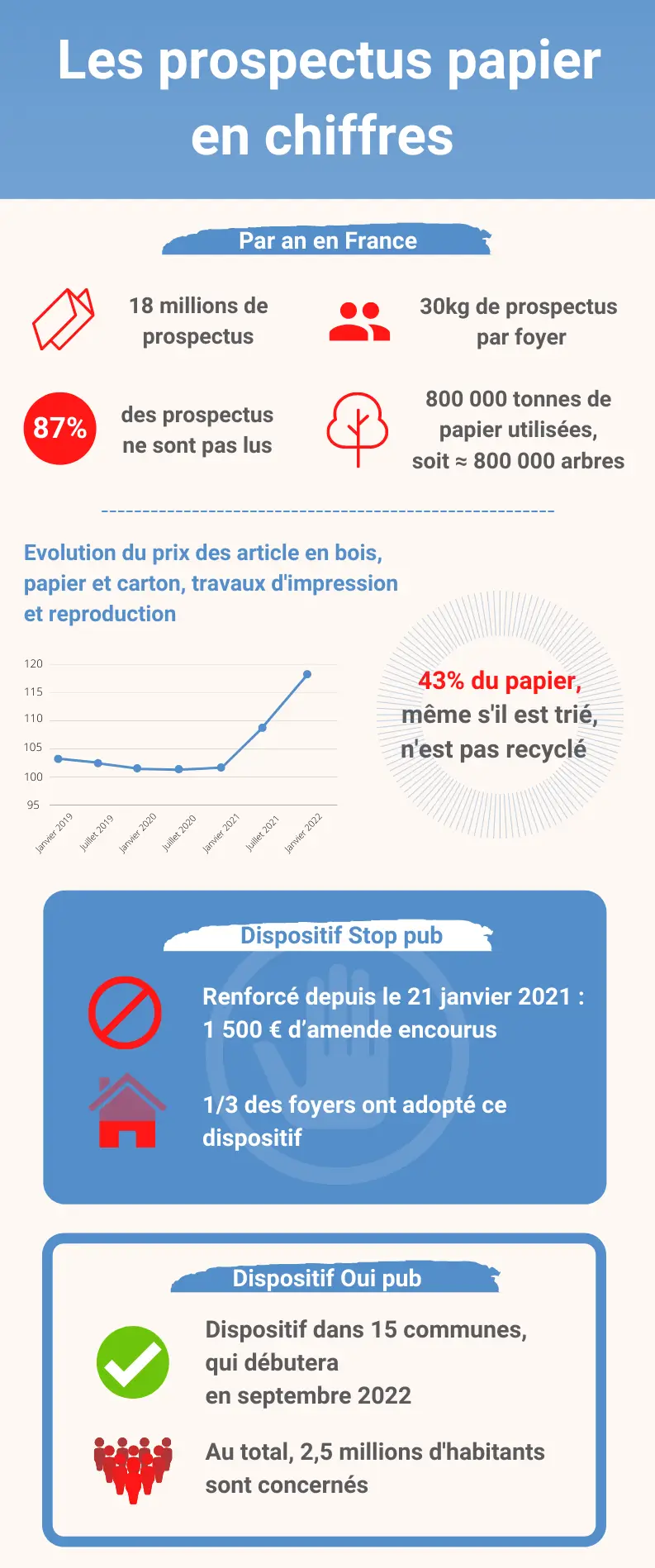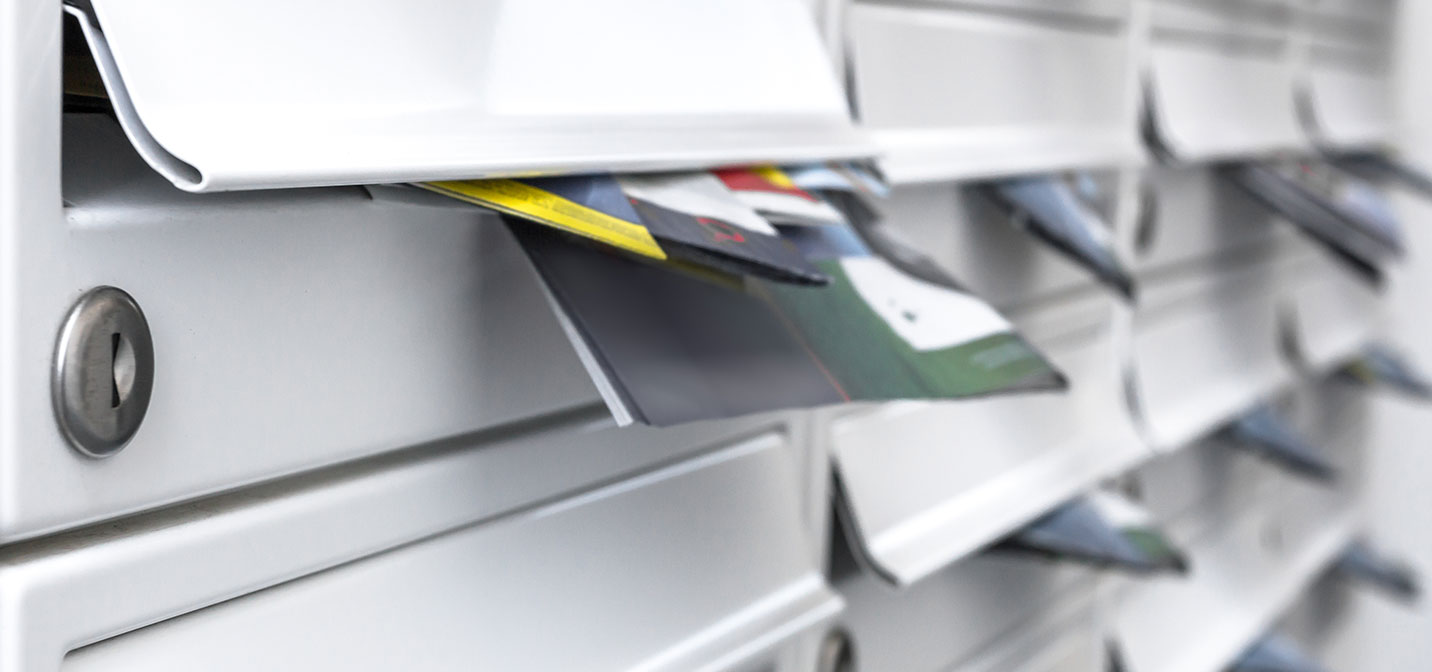Comme dans le monde du digital, le gouvernement privilégie aujourd’hui l’opt-in pour les supports papier. Le “Oui Pub” fait directement écho aux messages que nous pouvons souvent retrouver sur les boîtes aux lettres : “Stop pub”.
Cette nouvelle manière pour les consommateurs de déclarer s’ils veulent être exposés au publipostage rappelle l’introduction du RGPD, qui met en avant l’opt-in par rapport à l’opt-out. Les gens doivent exprimer leur accord afin de recevoir de la communication commerciale.
Dans cet article, nous allons vous expliquer comment “Oui Pub” a vu le jour et vous présenter les avantages du digital par rapport à la communication papier que nous avons très longtemps connue.
Le contexte “Oui Pub”
Il est annoncé que la nouvelle forme de consentement aux prospectus papier “Oui Pub” sera testée par 15 collectivités territoriales jusqu’en 2025. Depuis le 3 mai 2022, l’Etat a pris la décision de lancer cette expérimentation suite à un rapport de la ministre de la transition écologique. Cette action a pour but de ne distribuer des prospectus papier qu’aux foyers affichant leur consentement. L’objectif in fine est de réduire le nombre de prospectus imprimés.
D’après le site de Planetoscope, 27 kilos de prospectus et imprimés publicitaires sont distribués dans les boîtes aux lettres. Cela représente 17 kilos de papier par habitant, pour 18 milliards de prospectus annuels. Ces “imprimés sans adresse” représentent alors un budget marketing total de 2,8 milliards d’euros par an, dont 400 millions dépensés inutilement. Ces dépenses sont, de plus, vouées à augmenter, puisque les coûts de production des articles en bois, papier et carton sont supposés augmenter. D’après une prévision de l’INSEE, la valeur de l’indice de prix de la production doit atteindre 120,6, représentant une augmentation de 17,89% par rapport à N-1 (mars 2021).
Très utilisés par les retailers, les prospectus seront de plus en plus marginalisés par le déploiement d’actions telles que “Oui Pub” au fur-et-à-mesure de la prise de conscience écologique collective.

Comment adapter son mix-média ?
Tout d’abord, qu’est-ce qu’un mix-média ? Les annonceurs essaient constamment d’optimiser leurs processus ainsi que leurs budgets. Le mix-média correspond alors à une exploitation efficacement répartie des différents médias disponibles dans l’organisation des campagnes publicitaires. Clairement, cela veut dire prioriser les médias en fonction du retour sur investissement.
La limitation de l’utilisation du papier ainsi que l’évolution de la technologie poussent progressivement les commerçants et divers distributeurs à revoir leurs stratégies de communication. Cela est d’autant plus vrai dans notre société actuelle “hyper connecté” ; Internet permettant notamment de bénéficier d’une forte présence dans le quotidien des consommateurs.
Hybrider la communication
Qu’est-ce qu’il faut faire ? L’objectif est d’adapter son mix-média, donc, en adoptant une stratégie hybride de communication. Cela permet de bénéficier du meilleur des deux modalités :
- L’utilisation des prospectus digitaux coûte moins cher, et permet de limiter le gaspillage (fournissant un avantage de communication dans le cadre d’une potentielle stratégie RSE) ;
- La publicité digitale permet de cibler plus précisément les profils qualifiés, avec des outils analytics à disposition qui permettent de mesurer la performance des opérations, et donc d’optimiser les coûts.
Les enseignes souhaitant toujours profiter du format prospectus, il existe une modalité alternative en ligne. Cela permet effectivement de partager des prospectus digitaux qui reproduisent la même expérience que le prospectus papier; à savoir son large choix de produits mis en avant. Des régies publicitaires comme Azira permettent de digitaliser le format papier.
Certains retailers proposent déjà des prospectus 100% digitaux directement sur leur site. Dans leur feuille de route RSE, ces entreprises annoncent souhaiter réduire l’impact social et environnemental de leurs activités. Pour certain, le développement de l’activité E-commerce permet alors de développer une stratégie de catalogues 100% en ligne.
Trouver son mix-média
Il n’existe toutefois pas de mix-média parfait. Comme nous l’avons mentionné, le choix des médias à utiliser dans sa stratégie de communication dépend de plusieurs éléments, qui sont propres à chaque enseigne. Effectivement, en fonction des habitudes de la cible de consommateurs, des investissements de l’annonceur, des retours sur investissement, et bien d’autres éléments, le mix-média ne sera pas établi de la même manière.
Chaque retailer peut développer une stratégie bien adaptée à ses besoins et objectifs, qui peuvent être d’ailleurs d’ordre national ou plutôt local. En fonction, certaines enseignes optent pour des stratégies spécifiques sollicitant des leviers soit online ou/et offline.
Quels sont les avantages du digital sur le papier ?
Avec les évolutions technologiques et la mutation des comportements des consommateurs, les actions digitales s’imposent naturellement dans la stratégie média des marketeurs. Cela est particulièrement valable suite au dispositif “Oui Pub” où les actions digitales prennent tout leur sens pour répondre à des enjeux environnementaux et financiers.
L’optimisation du format papier en ligne
Les prospectus digitaux représentent des avantages, à la fois pour les consommateurs ainsi que pour les annonceurs. Effectivement, ces catalogues peuvent être agrémentés de fonctionnalités supplémentaires. Celles-ci peuvent par exemple ajouter des notions d’interactivité aux supports publicitaires.
On peut par exemple parler de la vidéo, qui vient faciliter la délivrabilité d’un message et optimiser la clarté de l’offre. A terme, cela aide à optimiser le taux de conversion. Les liens vont également dans ce sens. Une version online d’un prospectus peut être enrichie avec des liens directs vers les produits, dirigeant alors le consommateur vers une potentielle commande.
Concernant les liens redirectifs, il est également recommandé d’intégrer aux créations diffusées des CTAs (ou Call to Action) renvoyant vers une application de guidage qui indique à l’utilisateur le point de vente le plus proche de lui. Des boutons intitulés par exemple “J’y vais” ou “J’en profite” et qui incitent à se rendre en magasin. Ce genre de fonctionnalité permet de renforcer l’engagement du consommateur et ainsi optimiser le taux de conversion.
Enfin, le digital permet de faire une communication plus quantitative. C’est-à-dire que vous pouvez inclure davantage de produits, sans dépenser plus de papier, sur vos prospectus. Cela vous permet une large sélection de produits, montrant la profondeur de votre gamme de produits aux consommateurs, répondant alors à de potentiels besoins.
La dynamisation de la zone de chalandise
La zone de chalandise représente le périmètre d’où viendraient, théoriquement, les clients d’un point de vente. Traditionnellement, la zone de chalandise prend en compte le lieu de résidence des consommateurs, sans prendre en compte leurs déplacements ou ceux des personnes proches de cette zone (professionnels vers le lieu de travail par exemple, etc.).
Ainsi, le publipostage tel que nous le connaissons aujourd’hui se fait au sein d’une zone de chalandise fixe prenant en compte le lieu de résidence du client potentiel. Un concept traditionnellement ancré dans les méthodes de diffusion d’un directeur de magasin, mais qui peut être agrémenté grâce à l’analyse des comportements online et offline.
Combiner les données online et offline permet de prendre en compte davantage d’informations afin de proposer une communication adaptée au consommateur. Ainsi, avec les données géographiques (lieu de travail, de fréquentations…), vous avez l’opportunité de cartographier les déplacements des consommateurs. Cela vient dynamiser et donner une nouvelle impulsion à votre zone de chalandise, alors fixe et établie sur les lieux de vie.
Les ressources temporelles et financières dédiées au publipostage de masse, basé sur la zone de chalandise traditionnelle, peuvent être réorientées et optimisées dans un processus de communication adapté, mentionné précédemment. Les consommateurs reçoivent des prospectus digitaux adaptés, les renvoyant par exemple grâce à d’éventuels CTAs vers le magasin le plus proche.
La digitalisation des prospectus permet de dynamiser et d’agrandir cette zone de chalandise. Effectivement, les coûts et le temps incombés au publipostage physique sont réduits grâce aux prospectus et catalogues digitaux, proposés aux bonnes personnes en fonction de leurs déplacements cartographiés.
La mesure des performances
La distribution de prospectus en boîtes aux lettres ne permet pas de mesurer précisément les performances. Habituellement, à la suite d’ un envoi de prospectus, il est difficile pour un annonceur de calculer son retour sur investissement. Combien de consommateurs sont vraiment venus suite à la réception du prospectus ? Avaient-ils prévu de passer avant d’avoir reçu les prospectus ?
Vous ne connaissez ainsi pas le taux de conversion réel de votre opération. Les campagnes online peuvent être mesurées beaucoup plus précisément, notamment en prenant en compte le taux de clic. Vous pouvez placer des UTM de suivi dans vos liens, sur le prospectus, ce qui vous permettra de connaître précisément le nombre de personnes ayant cliqué sur vos produits.
Si vous voulez obtenir une idée plus précise du comportement du consommateur face à vos prospectus, vous pouvez faire de l’A/B testing. Envoyez deux différentes versions de visuel à votre base de destinataires. Observez celle qui obtient le plus de résultats, et faites évoluer votre support au fil des envois.
L’analyse des performances permises par la digitalisation des prospectus aide à développer une stratégie de retargeting. La connaissance des profils déjà engagés permet effectivement de proposer des communications plus personnalisées, optimisant davantage le taux de conversion sur les campagnes suivantes.
Enfin, il est possible de mesurer l’incrémentalité dans votre stratégie offline. Aussi appelée mesure incrémentale, elle permet d’améliorer la planification média et d’anticiper l’allocation des dépenses. Cette stratégie est le quasi-équivalent de l’A/B testing dans l’offline. Cela correspond donc à comparer le taux de visite d’un groupe A, exposé à un message, par rapport à un groupe B, non exposé au message.
Le fait de créer une différence d’exposition au message entre les deux groupes vous permet de calculer l’augmentation potentielle de visites que génère le message que vous diffusez. En comparant le comportement des deux groupes, vous aurez une meilleure vision des performances de vos opérations.
L’après “Oui Pub”, en conclusion
L’action “Oui Pub” permet d’aller dans le sens des mentalités générales et des actualités environnementales. Cela ne signifie pas la fin des prospectus. Comme nous avons pu le voir, l’hybridation est une solution possible bénéficiant à un point de vente sur plusieurs aspects.
Des campagnes plus récurrentes et rentables peuvent être organisées, tout en optimisant votre capacité de mesure afin de proposer des prospectus adaptés aux besoins des consommateurs.



